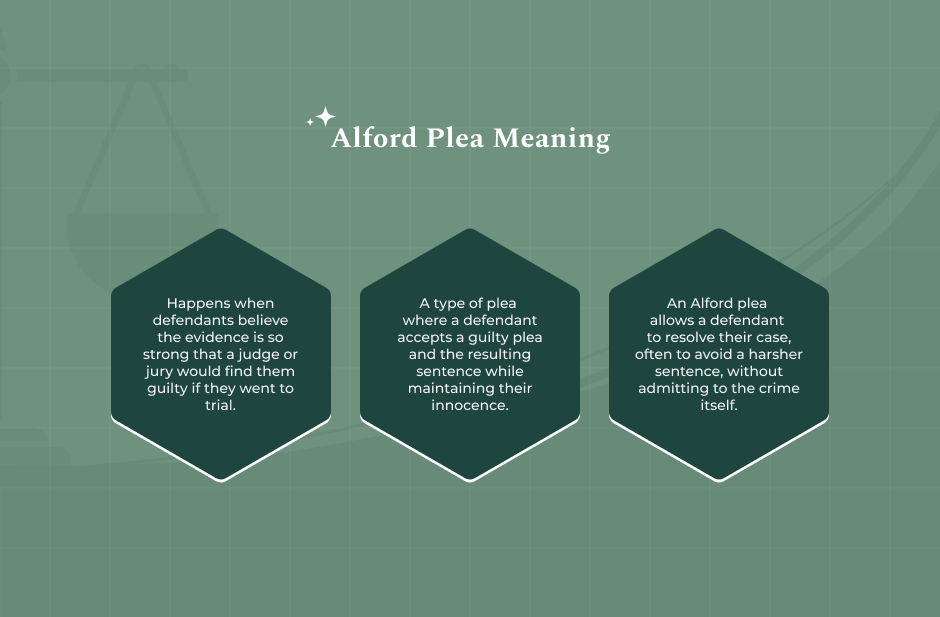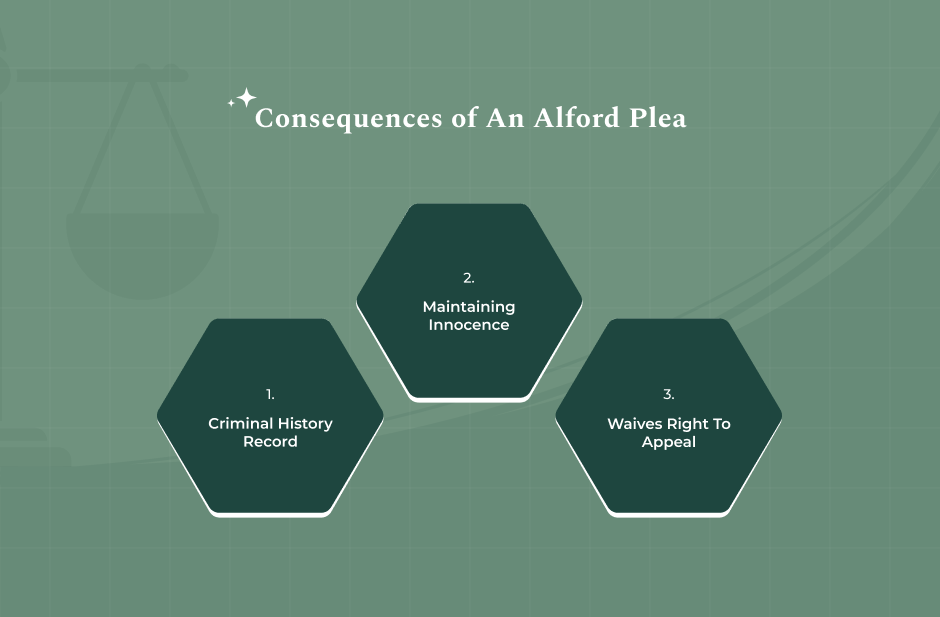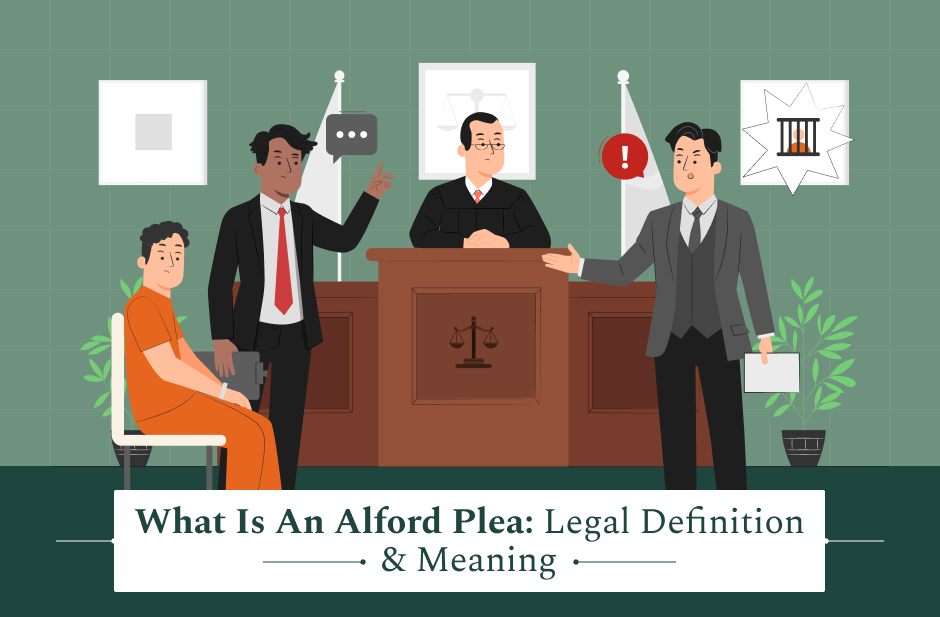In the U.S. criminal justice system, defendants can choose from several options to change their plea: guilty, not guilty, or no contest. Yet, there exists another lesser-known plea, which is a mixture of the elements of guilty and not guilty — the Alford plea.
Although it is not accessible in all areas, it has a significant legal impact. With this plea, a defendant is allowed to agree to be convicted yet keep their innocence.
The term comes from the case North Carolina v. Alford (1970), in which the U.S. Supreme Court decided that defendants could make a guilty plea without an outright confession to the crime if such a plea is voluntary and made with understanding.
Knowing the Alford plea is necessary for defendants, lawyers, and anyone who has an interest in criminal law. This is because it shows how the justice system merges efficiency, fairness, and the rights guaranteed by the Constitution.
In this article, I will explain the following things:
- What is an Alford plea?
- The different types of Alford plea.
- The key aspects of an Alford plea.
- How does the plea work?
- What is the legal impact of such a plea?
Additionally, I will also talk about some of the most common questions that people often ask when they are searching for what is an Alford plea. Therefore, if these are some of the things that you want to know, keep on reading this blog till the end…
What Is An Alford Plea?

An Alford plea, after the famous Supreme Court case, North Carolina v. Alford, 400 U.S. 25 (1970), is a type of guilty plea where the defendant maintains their innocence and yet agrees that the prosecution’s evidence is likely strong enough to convince a jury of their guilt beyond a reasonable doubt.
Henry Alford, a criminal defendant, was charged with first-degree murder. The defendant could have been sentenced to death as a capital offense if a jury had declared him guilty.
Law Info reports that there was a lot of evidence against Alford, however, his criminal defense lawyer advised him to make a guilty plea. The prosecutor agreed to a plea of guilt for second-degree murder, which carries a jail sentence from two to 30 years, according to the report.
“Alford pleaded guilty but said he was not guilty. Instead, he said he was admitting guilt to avoid the death penalty. The Supreme Court held that the court could accept a guilty plea based on a voluntary and intelligent choice even if the defendant continues to claim innocence,” according to Law Info.
According to Merriam-Webster, an Alford plea is basically “a guilty plea entered by a criminal defendant who does not admit guilt but nevertheless pleads guilty as part of a plea bargain.”
Fundamentally, it is the defendants who are provided with an opportunity to refrain from taking trials and subsequently the risks that go along (e.g., a severe sentence), but at the same time not to give a direct statement of guilt. Justia clearly mentions that this plea “allows a defendant to plead guilty while maintaining their innocence.”
Courts treat it as a guilty plea, meaning the defendant will be convicted and sentenced as if they admitted guilt outright.
What Are The Types Of Alford Plea?
Though the Alford plea is itself a separate type, it is still often compared with or placed in the same group of similar kinds of pleas:
1. Standard Alford Plea: The accused admits innocence but accepts guilt as a result of available evidence that is too strong to counter.
2. Hybrid Plea (Alford + Negotiated Plea): Typically, a plea of this type is used in plea bargaining, whereby the defendant consents to a lesser charge or a more lenient sentence with the help of an Alford plea.
3. Comparison with Other Pleas:
- No Contest (Nolo Contendere): The defendant does not admit or deny the charge and takes the verdict. In contrast with an Alford plea, no declaration of innocence is made.
- Traditional Guilty Plea: The defendant confesses to committing the crime.
- Not Guilty Plea: The accused rejects the accusation and goes on trial.
It is these differences that matter, that some states may conditionally restrict and entirely disallow differentials of Alford type based on the characterization of the crime being committed.
What Are The Key Aspects Of An Alford Plea?
The New York State Court Documents describe an Alford plea as follows:
An Alford plea requires “strong” evidence of guilt and a demonstrated “rational choice.” The defendant must be “aware of the nature and character of an Alford plea,” and at the least should be asked if he wishes to plead guilty to the crime “to avoid the risk of conviction upon a trial of the more serious crime….”
Apart from these, there are several attributes that define an Alford plea. These key elements or aspects are as follows:
- Maintains Innocence
- Acknowledges Evidence.
- Treated as Guilty in Court
- Voluntary and Intelligent Choice
- Limited Availability
Note: The U.S. Attorneys’ Manual from the Department of Justice states that when it comes to the federal system, it is best to avoid Alford pleas “except in the most unusual circumstances.” This is because, according to United States v. Bednarski, 445 F.2d 364, 366 (1st Cir. 1971), “the public might well not understand or accept the fact that a defendant who denied his guilt was nonetheless placed in a position of pleading guilty and going to jail.”
How Does An Alford Plea Happen?
Now that you are aware of what is an Alford plea, let me explain the steps for the process of the same. Here’s how an Alford plea happens:
- Negotiation: Defense attorneys and prosecutors discuss the possibility of an Alford plea, usually as part of plea bargaining.
- Court Hearing: The defendant appears before a judge to formally enter the plea.
- Judicial Inquiry: The judge questions the defendant to ensure they understand the plea’s consequences and are entering it voluntarily.
- Review of Evidence: The court often requires the prosecution to present enough evidence on record to justify the plea.
- Acceptance and Sentencing: If accepted, the court records the plea as a guilty plea and proceeds with sentencing.
What Are The Legal Impact Of An Alford Plea?

The effects or legal influence of the Alford plea are something that extends beyond a courtroom. Here are some of the major legal impacts that you need to be aware of:
- Conviction Status: It is a guilty conviction just as a plea of guilty, but in this case, it is a silent consent one, so it is still on the person’s criminal record.
- Civil Liability: Unlike a no-contest plea, the Alford plea may be used to help in identifying the defendant in the related civil lawsuits.
- Appeals and Post-Conviction Relief: As the Alford plea is classified as a guilty one, defendants can only appeal under limited conditions.
- Sentencing Outcomes: Judges may take into account the fact that the defendant did not admit to the crime when they make their decision on the sentence or parole.
- Collateral Consequences: The judgment may have an impact on the holding of the job, professional licenses, immigration status, and the right to vote.
Some commentators hold the view that Alford pleas constitute a threat to the principle of taking responsibility for one’s actions. However, at the same time, some argue that these are a convenient and realistic way to escape prolonged trials and getting even worse penalties.
Frequently Asked Questions (FAQs):
Here are some of the questions that people often ask about when searching about what is an Alford plea. Take a look at them before you go:
1. Is An Alford Plea The Same As Pleading Guilty?
It is not entirely the same. The final outcome is a guilty conviction in the case of an Alford plea, but the defendant does not acknowledge the guilt.
2. Can An Alford Plea Be Rejected By A Judge?
Definitely. A judge has the power to deny the plea if he considers that it is coerced, or there is not enough evidence to support it.
3. Do All States Accept Alford Pleas?
Not all. The majority of places are familiar with them, but there are still some states where such pleas are banned or restricted.
















